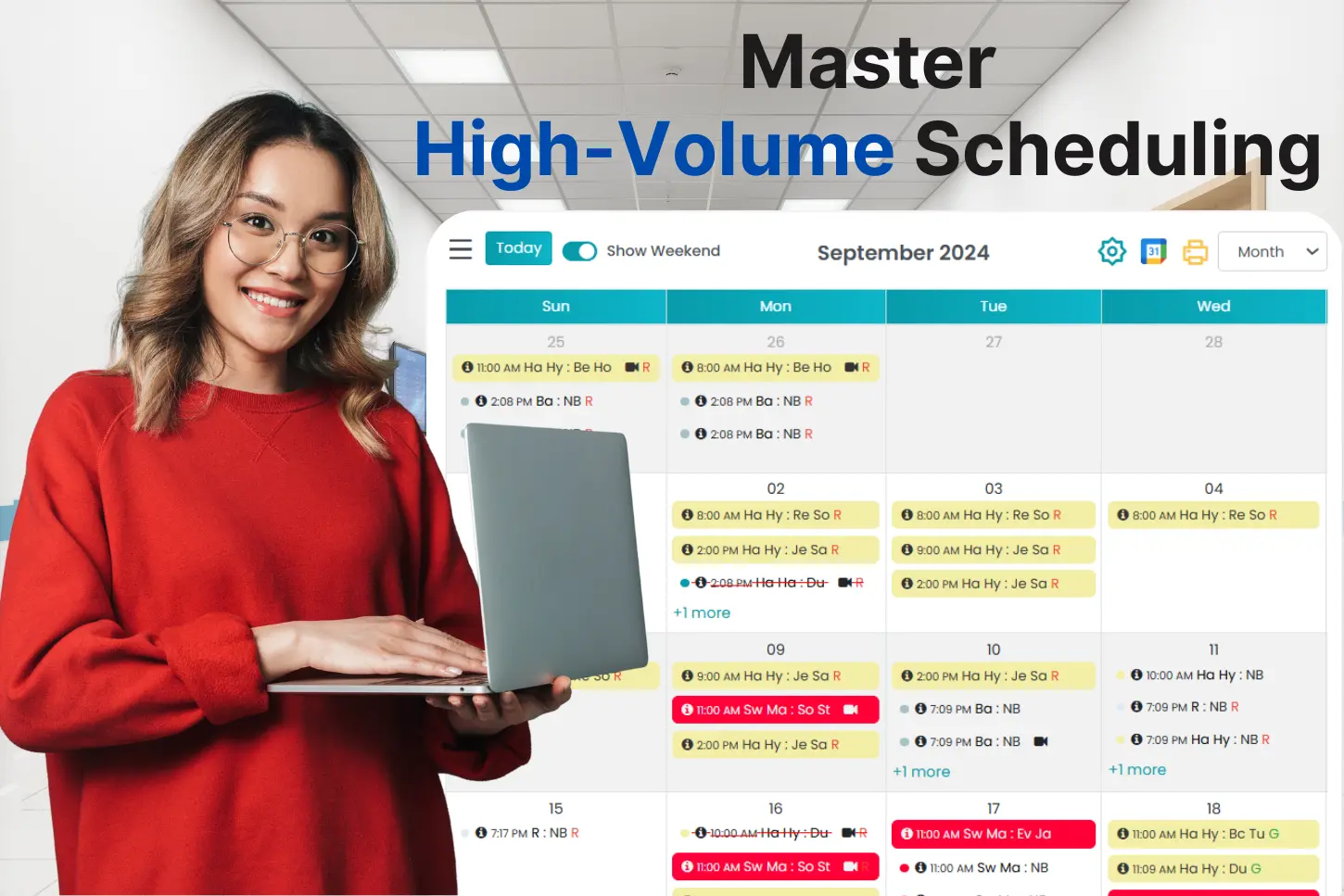
High-Volume Scheduling Tips for Therapists: Boost Efficiency & Care
Mental health care is rapidly growing, with the Behavioral Therapy Market expected to reach $187.4 billion by 2025, expanding at a rate of 8.4% annually. As more individuals seek therapy, therapists are faced with the challenge of managing an ever-increasing number of appointments. For many practices, this surge means juggling multiple clients daily, High-Volume Scheduling can be overwhelming without the right systems in place.
But what does this growth mean for your practice? How can you handle the influx of clients while ensuring quality care and maintaining your sanity?
In this blog, we’ll explore practical solutions to help you stay organized and efficient as you manage high-volume scheduling demands.
Key Takeaways
- Understand the common challenges therapists face when managing high-volume scheduling and how it impacts their practice.
- Learn practical strategies and tools to streamline appointment scheduling, minimize no-shows, and optimize your workflow.
- Discover how to balance efficiency with quality care, ensuring both your clients and your practice thrive as demand grows.
Challenges of High-Volume Scheduling
As the demand for mental health services continues to grow, managing a large number of clients can become increasingly difficult. Without a proper system in place, therapists may face several challenges that can disrupt their workflow and impact their ability to provide quality care:
- Overbooked schedules: Handling a high volume of appointments increases the likelihood of double bookings, miscommunication, or last-minute cancellations, causing stress for both you and your clients.
- Administrative burden: Manually managing multiple client schedules, tracking no-shows, and rescheduling appointments can quickly overwhelm your administrative tasks, leading to potential errors and burnout.
- Inconsistent client experience: When schedules aren’t optimized, clients might experience long waiting times, frequent rescheduling, or session delays, negatively affecting their experience and progress in therapy.
- Missed opportunities for growth: Focusing on scheduling rather than client care can limit your ability to expand your practice or take on new clients.
These hurdles make it clear why streamlining your scheduling process is crucial to keeping your practice running smoothly.
How to Streamline High-Volume Scheduling for Your Practice
Managing a high volume of appointments doesn’t have to be overwhelming. With the right strategies and tools, you can streamline your scheduling process and reduce the burden on both you and your staff. Here are some practical ways to improve your scheduling workflow:
- Use an automated scheduling system: Automating your appointment booking process can help eliminate manual errors and ensure that clients can easily schedule, reschedule, or cancel sessions online. This reduces the administrative load and minimizes double bookings or scheduling conflicts.
- Implement time-blocking techniques: Organize your day into specific time blocks for client sessions, administrative tasks, and breaks. This not only helps prevent overbooking but also ensures you have dedicated time for non-client tasks, like paperwork or client follow-ups.
- Leverage client self-scheduling: By allowing clients to book their appointments through an online portal, you save time and empower clients to manage their own schedules. This can also reduce the number of missed appointments, as clients can choose times that work best for them.
- Set up automated appointment reminders: Sending out reminders via email or SMS a day before the appointment reduces no-shows and ensures clients remember their scheduled sessions.
- Monitor and adjust: Regularly review your scheduling process to identify bottlenecks or inefficiencies. Make adjustments based on feedback from both clients and staff to continually improve your practice’s workflow.
By implementing these strategies, you can optimize your scheduling, reduce stress, and focus more on delivering quality care.
Looking for a more streamlined scheduling solution? TherapyPM simplifies appointment management with easy scheduling, unlimited reminders to reduce no-shows, and seamless calendar integration with Google Calendar. Optimize your workflow while enhancing your client experience.

Balancing Efficiency and Client Care
Effectively managing a busy schedule is essential for therapists, but it should never come at the expense of quality client care. Here are some strategies to achieve that balance:
- Prioritize Time Management: Use time-blocking techniques to allocate specific periods for client sessions, administrative tasks, and self-care. This ensures you have dedicated time for each aspect of your practice.
- Set Realistic Client Loads: Understand your limits and adjust your caseload accordingly. Avoid overloading yourself, which can lead to burnout and decreased care quality.
- Encourage Open Communication: Foster an environment where clients feel comfortable discussing their needs and concerns. This can enhance the therapeutic relationship while ensuring you remain responsive to their needs.
- Utilize Efficient Tools: Invest in practice management software that streamlines administrative tasks, allowing you to focus more on your clients.
- Incorporate Regular Breaks: Schedule short breaks between sessions to recharge and refocus. This can improve your energy levels and help maintain the quality of care you provide.
- Delegate Administrative Tasks: If possible, consider hiring administrative staff or utilizing virtual assistants to handle scheduling and paperwork, freeing you up to concentrate on client care.
- Implement Client Feedback: Regularly seek client feedback to understand their experiences and needs better. This can help you adjust your approach and ensure that their concerns are addressed promptly.
By implementing these strategies, you can maintain high-quality care while efficiently managing your schedule, ensuring that both you and your clients thrive.
Final Thoughts
Managing high-volume scheduling is a crucial aspect of running a successful therapy practice, especially in a rapidly growing field like mental health. By implementing effective scheduling strategies, utilizing technology, and prioritizing client care, therapists can navigate the challenges of increased demand while ensuring their clients receive the attention and support they need.
Striking the right balance between efficiency and quality care not only enhances the therapeutic experience but also contributes to the long-term success and growth of your practice. Embrace these techniques and empower yourself to thrive in this dynamic environment.





